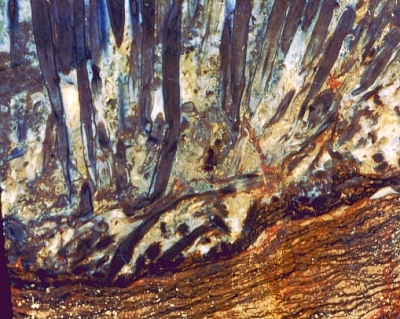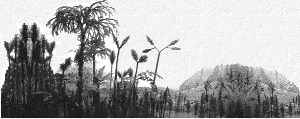

|
Whereas single individuals of
Aglaophyton
major with their creeping axes could already occupy larges surfaces,
Rhynia gwynne- vaughanii had a more thicket-like to bushy
appearance.
The specimen illustrated at left shows numerous very densely standing
axes.
The axes of this leafless plant bifurcated only occasionally but they borne
many lateral axes. These lateral axes were occasionally dropped off,
being a mode of vegetative propagation. Only the basal parts of the
axes were lying directly on the substrate. All more distal parts
of axes were standing upright. It is very remarkable that also upright
standing aerial axes frequently have rhizoids, obviously for taking up
atmospheric water. Plants like Rhynia probably had real difficulties
taking up sufficient water. Both the symbiosis with vesicular
arbuscular
mycorrhizae and the presence of rhizoids on the aerial shoots were certainly
advantageous. Also the bushy growth form might have been beneficial because
axes shaded each other and only few axes were exposed to direct sunlight thus reducing
the risk of excessive
evapotranspiration.
Rhynia occurred on various substrates, ranging from siliceous rocks
to sandy soils (see the picture left below). In the sandy soil seen an
the picture at left organic detritus can be recognized as thin black layers:
higher land plants had started to contribute to the formation of soils
! |



